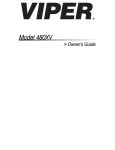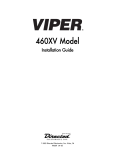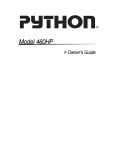Download 460XV Model - Net
Transcript
460XV Model
➤Owner’s Guide
limited lifetime consumer warranty
Directed Electronics, Inc. ("Directed") promises to the original purchaser to repair or
replace with a comparable reconditioned model any Directed unit (hereafter the "unit"),
excluding without limitation the siren, the remote transmitters, the associated sensors and
accessories, which proves to be defective in workmanship or material under reasonable use
during the lifetime of the vehicle provided the following conditions are met: the unit was
professionally installed and serviced by an authorised Directed dealer; the unit will be professionally reinstalled in the vehicle in which it was originally installed by an authorised
Directed dealer; and the unit is returned to Directed, shipping prepaid with a legible copy
of the bill of sale or other dated proof of purchase bearing the following information: consumer's name, telephone number and address; the authorised dealers name, telephone
number and address; complete product description, including accessories; the year, make
and model of the vehicle; vehicle license number and vehicle identification number. All
components other than the unit, including without limitation the siren, the remote transmitters and the associated sensors and accessories, carry a one-year warranty from the date
of purchase of the same. This warranty is non-transferable and is automatically void if: the
original purchaser has not completed the warranty card and mailed it within ten (10) days
of the date of purchase to the address listed on the card; the unit's date code or serial number is defaced, missing or altered; the unit has been modified or used in a manner contrary to its intended purpose; the unit has been damaged by accident, unreasonable use,
neglect, improper service, installation or other causes not arising out of defects in materials or construction. The warranty does not cover damage to the unit caused by installation or removal of the unit. Directed, in its sole discretion, will determine what constitutes excessive damage and may refuse the return of any unit with excessive damage. TO
THE MAXIMUM EXTENT ALLOWED BY LAW, ALL WARRANTIES, INCLUDING BUT NOT LIMITED TO EXPRESS WARRANTY, IMPLIED WARRANTY,
WARRANTY OF MERCHANTABILITY, FITNESS FOR PARTICULAR PURPOSE
AND WARRANTY OF NON-INFRINGEMENT OF INTELLECTUAL PROPERTY,
ARE EXPRESSLY EXCLUDED; AND DIRECTED NEITHER ASSUMES NOR
AUTHORIZES ANY PERSON OR ENTITY TO ASSUME FOR IT ANY DUTY,
OBLIGATION OR LIABILITY IN CONNECTION WITH ITS PRODUCTS.
DIRECTED DISCLAIMS AND HAS ABSOLUTELY NO LIABILITY FOR ANY
AND ALL ACTS OF THIRD PARTIES INCLUDING ITS AUTHORISED DEALERS OR INSTALLERS. DIRECTED SECURITY SYSTEMS, INCLUDING THIS
UNIT, ARE DETERRENTS AGAINST POSSIBLE THEFT. DIRECTED IS NOT
OFFERING A GUARANTEE OR INSURANCE AGAINST VANDALISM, DAMAGE OR THEFT OF THE AUTOMOBILE, ITS PARTS OR CONTENTS; AND
HEREBY EXPRESSLY DISCLAIMS ANY LIABILITY WHATSOEVER, INCLUDING WITHOUT LIMITATION, LIABILITY FOR THEFT, DAMAGE AND/OR
VANDALISM. THIS WARRANTY DOES NOT COVER LABOR COSTS FOR
MAINTENANCE, REMOVAL OR REINSTALLATION OF THE UNIT OR ANY
© 2005 directed electronics, inc.
3
CONSEQUENTIAL DAMAGES OF ANY KIND. IN THE EVENT OF A CLAIM
OR A DISPUTE INVOLVING DIRECTED OR ITS SUBSIDIARY, THE PROPER
VENUE SHALL BE SAN DIEGO COUNTY IN THE STATE OF CALIFORNIA.
CALIFORNIA STATE LAWS AND APPLICABLE FEDERAL LAWS SHALL APPLY
AND GOVERN THE DISPUTE. THE MAXIMUM RECOVERY UNDER ANY
CLAIM AGAINST DIRECTED SHALL BE STRICTLY LIMITED TO THE
AUTHORISED DIRECTED DEALER'S PURCHASE PRICE OF THE UNIT.
DIRECTED SHALL NOT BE RESPONSIBLE FOR ANY DAMAGES WHATSOEVER, INCLUDING BUT NOT LIMITED TO, ANY CONSEQUENTIAL DAMAGES,
INCIDENTAL DAMAGES, DAMAGES FOR THE LOSS OF TIME, LOSS OF
EARNINGS, COMMERCIAL LOSS, LOSS OF ECONOMIC OPPORTUNITY
AND THE LIKE. NOTWITHSTANDING THE ABOVE, THE MANUFACTURER
DOES OFFER A LIMITED WARRANTY TO REPLACE OR REPAIR THE CONTROL MODULE AS DESCRIBED ABOVE. Some territories do not allow limitations
on how long an implied warranty will last or the exclusion or limitation of incidental or
consequential damages. This warranty gives you specific legal rights and you may also have
other rights that vary from State to State or country to country.
Directed security systems, including this unit, are deterrents against possible theft.
Directed is not offering a guarantee or insurance against vandalism, damage or theft of the
automobile, its parts or contents; and hereby expressly disclaims any liability whatsoever,
including without limitation, liability for theft, damage and/or vandalism. Directed does
not and has not authorised any person or entity to create for it any other obligation,
promise, duty or obligation in connection with this security system.
Make sure you have all of the following information from your dealer:
A clear copy of the sales receipt and installation certificate, showing the following:
➤
➤
➤
➤
➤
➤
➤
➤
4
Date of purchase
Your full name and address
Authorised dealer's company name and address
Type of alarm installed
Year, make, model and colour of the vehicle
Vehicle registration number
Vehicle identification number
All security options installed on the vehicle
© 2005 directed electronics, inc.
table of contents
limited lifetime consumer warranty . . . . . . . . . . . . . . . . . . . . . . . . . . . . . . . . . . . . . . . 3
standard transmitter configuration . . . . . . . . . . . . . . . . . . . . . . . . . . . . . . . . . . . . . . . . 7
what is included . . . . . . . . . . . . . . . . . . . . . . . . . . . . . . . . . . . . . . . . . . . . . . . . . . . . . . 8
important information . . . . . . . . . . . . . . . . . . . . . . . . . . . . . . . . . . . . . . . . . . . . . . . . . 8
system maintenance . . . . . . . . . . . . . . . . . . . . . . . . . . . . . . . . . . . . . . . . . . . . . . 9
your warranty . . . . . . . . . . . . . . . . . . . . . . . . . . . . . . . . . . . . . . . . . . . . . . . . . . . 9
transmitter functions . . . . . . . . . . . . . . . . . . . . . . . . . . . . . . . . . . . . . . . . . . . . . . . . . . 9
standard configuration . . . . . . . . . . . . . . . . . . . . . . . . . . . . . . . . . . . . . . . . . . . 10
using your system . . . . . . . . . . . . . . . . . . . . . . . . . . . . . . . . . . . . . . . . . . . . . . . . . . . 11
active arming. . . . . . . . . . . . . . . . . . . . . . . . . . . . . . . . . . . . . . . . . . . . . . . . . . . 11
passive arming. . . . . . . . . . . . . . . . . . . . . . . . . . . . . . . . . . . . . . . . . . . . . . . . . . 12
one-time bypass. . . . . . . . . . . . . . . . . . . . . . . . . . . . . . . . . . . . . . . . . . . . . . . . . 13
transmitter sensor disable . . . . . . . . . . . . . . . . . . . . . . . . . . . . . . . . . . . . . . . . . 14
autoimmobilisation . . . . . . . . . . . . . . . . . . . . . . . . . . . . . . . . . . . . . . . . . . . . . . 14
high security disarm . . . . . . . . . . . . . . . . . . . . . . . . . . . . . . . . . . . . . . . . . . . . . 15
disarming without a transmitter . . . . . . . . . . . . . . . . . . . . . . . . . . . . . . . . . . . . 16
entering your PIN. . . . . . . . . . . . . . . . . . . . . . . . . . . . . . . . . . . . . . . . . . . . . . . 16
interior light control . . . . . . . . . . . . . . . . . . . . . . . . . . . . . . . . . . . . . . . . . . . . . 17
silent mode . . . . . . . . . . . . . . . . . . . . . . . . . . . . . . . . . . . . . . . . . . . . . . . . . . . . 18
valet mode. . . . . . . . . . . . . . . . . . . . . . . . . . . . . . . . . . . . . . . . . . . . . . . . . . . . . 18
diagnostics . . . . . . . . . . . . . . . . . . . . . . . . . . . . . . . . . . . . . . . . . . . . . . . . . . . . . . . . . 20
arming diagnostics . . . . . . . . . . . . . . . . . . . . . . . . . . . . . . . . . . . . . . . . . . . . . . 20
disarming diagnostics . . . . . . . . . . . . . . . . . . . . . . . . . . . . . . . . . . . . . . . . . . . . 21
system status chirps . . . . . . . . . . . . . . . . . . . . . . . . . . . . . . . . . . . . . . . . . . . . . . 21
table of zones . . . . . . . . . . . . . . . . . . . . . . . . . . . . . . . . . . . . . . . . . . . . . . . . . . 22
interpreting zone diagnostics . . . . . . . . . . . . . . . . . . . . . . . . . . . . . . . . . . . . . . . 22
code hopping . . . . . . . . . . . . . . . . . . . . . . . . . . . . . . . . . . . . . . . . . . . . . . . . . . . . . . . 23
high frequency . . . . . . . . . . . . . . . . . . . . . . . . . . . . . . . . . . . . . . . . . . . . . . . . . . . . . . 24
owner recognition . . . . . . . . . . . . . . . . . . . . . . . . . . . . . . . . . . . . . . . . . . . . . . . . . . . 24
rapid resume logic . . . . . . . . . . . . . . . . . . . . . . . . . . . . . . . . . . . . . . . . . . . . . . . . . . . 25
power saver mode . . . . . . . . . . . . . . . . . . . . . . . . . . . . . . . . . . . . . . . . . . . . . . . . . . . 25
programming . . . . . . . . . . . . . . . . . . . . . . . . . . . . . . . . . . . . . . . . . . . . . . . . . . . . . . . 26
vehicle recovery system (vrs®) . . . . . . . . . . . . . . . . . . . . . . . . . . . . . . . . . . . . . . . . . . 28
arming the vrs® . . . . . . . . . . . . . . . . . . . . . . . . . . . . . . . . . . . . . . . . . . . . . . . . 29
vrs® triggered sequence . . . . . . . . . . . . . . . . . . . . . . . . . . . . . . . . . . . . . . . . . . 29
disarming the vrs® . . . . . . . . . . . . . . . . . . . . . . . . . . . . . . . . . . . . . . . . . . . . . . 30
programming options . . . . . . . . . . . . . . . . . . . . . . . . . . . . . . . . . . . . . . . . . . . . . . . . 31
ultrasonic sensors . . . . . . . . . . . . . . . . . . . . . . . . . . . . . . . . . . . . . . . . . . . . . . . . . . . . 32
glossary of terms . . . . . . . . . . . . . . . . . . . . . . . . . . . . . . . . . . . . . . . . . . . . . . . . . . . . 34
health check . . . . . . . . . . . . . . . . . . . . . . . . . . . . . . . . . . . . . . . . . . . . . . . . . . . . . . . . 37
© 2005 directed electronics, inc.
5
6
© 2005 directed electronics, inc.
standard transmitter configuration
controls the Lock–Arm function.
controls the Unlock–Disarm function.
controls Silent Mode™ and an Channel Output (2).
not used.
and
pressed together control an Channel Output (3).
and
pressed together control an Channel Output (4).
and
pressed together control an Channel Output (5).
and
pressed together control an Channel Output (6).
© 2005 directed electronics, inc.
7
what is included
➤
One control module and ultrasonic sensors
➤
A pair of four-button transmitters
Wire harnesses
➤
➤
➤
Two window decals
515ESP Battery Backup Siren
➤
Blue status LED indicator light
➤
A push-button Valet switch
Your warranty registration
XR external receiver/antenna
➤
➤
important information
Congratulations on the purchase of your state-of-the-art vehicle
security system. This system has been designed to provide years
of trouble-free operation. Due to the complexity of this system,
it must be installed by an authorised dealer only. Installation of
this product by anyone other than an authorised dealer voids the
warranty. All dealers are provided with preprinted dealer certificates to verify that they are authorised.
This owner’s guide should help you to get the most out of your
system. Please take the time to read it prior to using the system.
note: Your system MUST be installed by an Authorised dealer in accordance with the instructions we supply them. The Viper 460XV system
is designed to be installed in any petrol or common rail diesel vehicle
with a 12-volt battery.
8
© 2005 directed electronics, inc.
note: The Installation Certificate must be completed by your installer at
the authorised dealer. Other than the remote controls, this system has no
user-serviceable parts. Your authorised dealer can correct any system
wiring problems and, if needed, can return any malfunctioning component to Directed Electronics for repair/replacement under the terms of
the Limited Lifetime Warranty printed at the beginning of this guide.
note: Making changes to the existing system will invalidate the certificate of installation.
➜ system maintenance
The system requires no specific maintenance. Your remote
control is powered by a small, lightweight 3 volt lithium battery
(CR2032) that will last approximately one year under normal
use. When the battery weakens, operating range will be reduced
and the LED on the remote will dim.
➜ your warranty
It is necessary to retain your sales receipt, which reflects that the
product was installed by an authorised dealer. For full details
regarding your warranty coverage, please refer to the consumer
warranty section of this guide.
transmitter functions
This system uses a computer-based learn routine to learn the
transmitter buttons. This makes it possible to assign any transmitter button to any system function. The transmitter initially
comes programmed with Standard Configuration, but may also
be customized by an authorised dealer. The buttons described in
this manual correspond to a Standard Configuration transmitter.
© 2005 directed electronics, inc.
9
➜ standard configuration
Button
The arming function is controlled by pressing this button for
one second.
Button
The disarming function is controlled by pressing this button for
one second.
Button
Silent Mode™ and an optional auxiliary function are controlled
by pressing this button. (Silent Mode works by pressing this
button for less than one second before arming or disarming. An
optional auxiliary function, such as boot release, can be
controlled by pressing this button for 1.5 seconds.)
This auxiliary output controls __________________________.
and
Buttons
An optional auxiliary convenience or expansion function that
you have added to your system can be activated by pressing these
buttons simultaneously.
This auxiliary output controls_________________________.
and
Buttons
An optional auxiliary convenience or expansion function that
you have added to your system can be activated by pressing these
buttons simultaneously.
This auxiliary output controls_________________________.
10
© 2005 directed electronics, inc.
and
Buttons
An optional auxiliary convenience or expansion function that
you have added to your system can be activated by pressing these
buttons simultaneously.
This output controls_________________________.
and
Buttons
An optional auxiliary convenience or expansion function that
you have added to your system can be activated by pressing these
buttons simultaneously.
This auxiliary output controls_________________________.
using your system
The buttons described in this manual correspond to the standard
configuration. Remember, this is not the only way your transmitter may be set up. It can be customised to meet your needs.
➜ active arming
You can activate, or arm, the system by pressing
on your
transmitter for one second. When the system arms, you will hear
a short siren sound, or chirp, and the indicator lights will flash
once. If the vehicle’s central door locking has been connected to
the system, the doors will lock.
© 2005 directed electronics, inc.
11
While the system is armed, the status LED will flash approximately once per second, indicating that the system is actively
protecting your vehicle. If you hear a second chirp after arming,
and see the status LED flashing in groups, refer to the Diagnostics
section of this guide. This extra chirp is called Bypass Notification.
➜ passive arming
The system also can be programmed to arm itself automatically
(called passive arming). If the system is programmed for passive
arming, it will automatically arm 30 seconds after the ignition is
turned off and the system "sees" you leave the vehicle by opening
and closing a door. Whenever the system is in its 30-second
passive-arming countdown, the status LED will flash twice as
fast as it does when the system is armed. The siren will chirp
once 20 seconds after the last door has been closed and the interior light has turned off. The system is not actually armed at that
point. The system arms and the doors lock (if connected and
programmed for passive locking) at the 30 second mark, but the
siren will not chirp. The early chirp provides you with a 10second warning prior to arming.
note: If any protected entry point (such as a door or a
switch-protected (boot or bonnet)) is open, the system
will not passively arm (unless forced passive arming is
programmed on). See Programming Options section of
this guide. Additionally, each time a protected entry is
triggered during the arming countdown, the 30-second
countdown starts from the beginning.
12
© 2005 directed electronics, inc.
When armed, your vehicle is protected as follows:
➤
Movement inside the passenger compartment will trigger
the system. The triggered sequence is 30 seconds of constant
siren and indicator light flashing.
➤
If a door is opened, the system will immediately trigger.
➤
Turning on the ignition key will trip the same two-stage
response as opening a door.
➤
The built-in triple circuit Immobiliser prevents the vehicle's
ignition, starter and fuel pump from operating.
➜ one-time bypass
This feature stops the alarm from arming or activating any
outputs that are programmed to activate when the alarm is
armed.
One-time bypass will defeat the following actions:
Passive arming: If programmed ON the alarm will not arm
itself.
If the remote is used to arm the alarm after exiting the vehicle:
Window roll up: If programmed ON this output will not
activate.
Linked Auxiliary Outputs: If programmed to activate on
arm, they will not activate.
© 2005 directed electronics, inc.
13
To activate one-time bypass:
1. After parking turn the ignition off.
2. Turn the ignition On for more than 1-second and less than
3-seconds.
3. The siren will chirp once to indicate one-time bypass has
been activated.
To cancel one-time bypass perform one of the following:
Arm then disarm the alarm.
Turn the ignition On for more than 3-seconds.
➜ transmitter sensor disable
To temporarily disable a sensor input, arm the system. Press the
button again and the system will respond with 3 indicator
flashes. This means all sensor warn-away triggers are bypassed.
Press the
button again and the system will respond with 4
indicator light flashes. This means all sensor warn-away and full
triggers are bypassed.
➜ autoimmobilisation
The built-in Triple Circuit Immobiliser will automatically arm
(indicated by a slow LED flash), 30 seconds after the ignition is
turned off. (This feature is a Thatcham and EC requirement and,
therefore, is not user-programmable.) To disarm the Immobiliser
when it has AutoImmobilised, either use the remote control to
arm and then disarm the system, or turn the ignition on and
press the
14
or
button or enter your 4-digit PIN code.
© 2005 directed electronics, inc.
➜ disarming
To disarm the system, press
. You will hear two chirps, and
the indicators will flash twice. If the vehicle's central locking is
connected to the system, the doors will unlock. If the siren chirps
either four or five times when disarming, refer to the Diagnostics
section of this guide. This is called Tamper Alert and means the
system has triggered while you were away.
➜ high security disarm
This security system offers High Security Disarm. High Security
Disarm is a feature that makes it possible to silence and reset the
system while it is triggering, without disarming the system. If the
system is triggered and the siren has been sounding for longer
than six seconds, pressing
or
on the remote transmitter
will stop the trigger and return the unit to the armed state. The
system will not disarm, but rather reset. This prevents you from
disabling the system should you wish to disarm it without visually checking the vehicle. Pressing
after resetting the system
will disarm the system; pressing this button during the first six
seconds of the triggered sequence will disarm the security system
immediately. The six second timer is provided for your convenience, in case the system is accidentally triggered.
© 2005 directed electronics, inc.
15
➜ disarming without a transmitter
This feature allows you to disarm the system without the transmitter should it be lost, damaged, or disabled. In order to disarm
without a transmitter, you must have the vehicle’s ignition key,
know where the Valet switch is located, and have the PIN code.
Check with the installer for the location of the Valet switch.
Please refer to the Disarm/Valet Mode section of this guide for
instructions to enter the pin code.
Location of Valet switch____________________________________.
PIN code_________________________________________________.
➜ entering your PIN
Entering your PIN code using the valet switch allows you to
disarm the system without using the transmitters. Your 4-digit
PIN code is noted on the back page of this manual. If you would
like to change this PIN for one that is easier for you to remember
please visit your installing dealer.
1. Turn the ignition key to the ON position.
2. Within 10 seconds, enter the first number in your PIN.
Press and release the Valet switch the same number of times
as the first digit in your PIN.
Example: If your PIN is 2345, press the Valet switch two
times.
3. Turn the ignition key OFF.
4. Turn the ignition key to the ON position.
16
© 2005 directed electronics, inc.
5. Enter the second number in your PIN (press the Valet switch
three times).
6. Turn the ignition key OFF.
7. Turn the ignition key to the ON position
8. Enter the third number in your PIN (press the Valet switch
four times).
9. Turn the ignition key OFF.
10. Turn the ignition key to the ON position.
11. Enter the last number in your PIN (press the Valet switch
five times).
12. Turn the ignition key OFF. If you have entered the correct
code you will hear two chirps. Should you hear five rapid
chirps, the correct code has not been entered. Begin entering
your PIN from the beginning.
➜ interior light control
security only
The interior light activates for 30-seconds after the system is
disarmed.
Ignition controlled
The interior light activates for 30-seconds after the ignition is
turned Off.
door controlled
The interior light activates for 30-seconds after the system sees a
door has closed. (If door was held open for longer than 3
minutes the interior light will not illuminate.)
© 2005 directed electronics, inc.
17
full
The interior light activates for 30-seconds after seeing door
closure, ignition, or security disarm. (This is the factory setting.)
➜ silent mode
To arm or disarm the system without siren chirps, use Silent
Mode™. Simply press
for less than one second before
arming or disarming, and the confirmation chirp(s) will be eliminated for that one operation only. If you want the arm/disarm
chirps turned off permanently, your dealer can do this for you.
note: The Warn Away® response from any optionally
installed sensors are bypassed if the system is armed using
Silent Mode. This ensures that no chirps will be emitted
by the siren in an area you want chirp-free. The system is
still fully capable of triggering. Only the Warn Away®
response is bypassed.
➜ valet mode
You can prevent your security system from automatically arming
and triggering by using Valet Mode. This is very useful when
washing the vehicle or having it serviced. In Valet Mode, the
security system will not arm, even with the remote transmitter,
but all convenience functions (door locks, boot release, etc.) will
continue to work normally.
18
© 2005 directed electronics, inc.
To enter Valet Mode:
1. Turn the ignition on.
2. Turn the ignition off.
3. Press and release the Valet
DRW-35
button within 10 seconds.
The status LED will light solidly to indicate the system has
entered Valet Mode.
To exit Valet Mode:
1. Turn the ignition on. The system will then automatically
exit Valet mode.
To enter or exit Valet Mode using the transmitter:
1. Open any vehicle door.
2. Press
.
3. Press
.
4. Press
again.
The status LED will light solidly if you are entering Valet Mode,
and it will go out if you are exiting Valet Mode.
© 2005 directed electronics, inc.
19
diagnostics
The microprocessor at the heart of your security system is
constantly monitoring all of the switches and sensors that are
connected to it. It detects any faulty switches and sensors and
prevents them from disabling the entire system. The microprocessor will also record and report any triggers that occurred
during your absence. Refer to the System Status Chirps and
Table of Zones charts for diagnostic information.
➜ arming diagnostics
If the system is armed while an input is active (door open, sensor
triggering, etc.) the unit will chirp once when arming and then
one more time a few seconds later. This is called Bypass
Notification.
note: Bypass Notification will not occur when using
Silent Mode™ or if chirps have been programmed OFF.
The security system will ignore the input that was active when
the system was armed, until the input goes away. Three seconds
later the system will monitor that input normally. For example,
if your vehicle’s boot was open, and you arm the system, you
will hear Bypass Notification chirps. If you close the boot it is
then monitored normally without the need to disarm and then
rearm the system.
20
© 2005 directed electronics, inc.
➜ disarming diagnostics
Extra disarm chirps are the Tamper Alert. If four chirps are heard
when disarming, the system was triggered in your absence. If five
chirps are heard, a zone was triggered so many times that Nuisance
Prevention® Circuitry has bypassed that zone. The status LED will
indicate which zone was involved. (See Table of Zones section of
this guide.) The system will retain this information in its memory,
and continue to chirp four or five times each time it is disarmed,
until the next time the ignition key is turned on.
➜ system status chirps
The siren will chirp when arming/disarming the system. The
pattern of chirps will audibly report the system’s status as
described below.
Action
Number of Chirps
Description
Arm
1
System armed
Arm
1 (3-second delay), 1
System armed with
Bypass Notification
Disarm
2
System disarmed
Disarm
4
System disarmed with
Tamper Alert
© 2005 directed electronics, inc.
21
➜ table of zones
The zone number is the number of LED flashes used by the
system to identify that input. The standard input assignments
are listed below, along with spaces to write in any optional
sensors or switches you have had installed.
Zone - Number
of LED Flashes
Description
1
Boot trigger
2
Ultrasonic Sensors
3
Door switch trigger
4
Optional sensor input 1
5
Ignition trigger
6
Bonnet trigger
7
Optional sensor input 2
Dealer-Installed
Options
➜ interpreting zone diagnostics
Warn Away responses are not reported by arming or disarming
diagnostics. If you receive a Bypass notification when arming or
a Tamper Alert notification when disarming, look at the LED.
Active or triggered zones will be indicated by a pattern of flashes
by the LED.
22
© 2005 directed electronics, inc.
Example
If Zone 3 was active or triggered, the LED will flash three times
with a two-second pause. Then it will flash three times again,
and repeat until the ignition is turned on.
note: Your system stores the last six triggered zones in
memory. If your system has been triggered but the LED
has been reset by turning on the ignition, your dealer can
still recall the last six zones that were triggered. Contact
your dealer for details.
code hopping
The receiver and transmitters each use mathematical formulas
called algorithms to change their codes each time the transmitter
is used. This technology has been developed to increase the security of the unit. The control unit knows what the next codes
should be. This helps to keep the transmitter "in sync" with the
control unit even if you use the remote control out of range of
the vehicle. However, if the transmitter has been pressed many
times out of range of the vehicle, or if the battery has been
removed, it may get out of sync with the control unit and fail to
operate the system. To re-sync the remote control simply press
of the transmitter several times within range of the vehicle.
The alarm will automatically re-sync and respond to the transmitters normally.
© 2005 directed electronics, inc.
23
high frequency
Your system transmits and receives at 433 MHz. This provides a
cleaner spectrum with less interference and a more stable signal.
owner recognition
Owner Recognition is a feature available exclusively from Directed.
Using the Directed Bitwriter®, a hand-held programming tool,
your dealer can program many of the system settings. The
programmer makes it possible to program different settings for
each transmitter that is used with the system. Then, whenever a
specific transmitter is used, the system will recall the settings
assigned to that transmitter. Owner Recognition lets up to four
users of the system have different settings that meet their specific
needs. It is almost like having four separate alarms in your vehicle,
one for each user.
note: Owner Recognition cannot be programmed without a Directed Bitwriter® and the necessary software.
Check with your dealer for more information.
24
© 2005 directed electronics, inc.
rapid resume logic
This Directed system will store its current state to non-volatile
memory. If power is lost and then reconnected, the system will
recall the stored state from memory. This means if the unit is in
Valet Mode and the battery is disconnected for any reason, such
as servicing the car, when the battery is reconnected the unit will
still be in Valet Mode. This applies to all states of the system
including arm, disarm, Autoimmobilised, VRS®, and Valet
Mode.
power saver mode
Your system will automatically enter Power Saver Mode while
armed or in Valet Mode, after a period of time in which no operation has been performed. This lowers the current draw to the
vehicle’s battery. Power Saver Mode takes over under the
following conditions:
➤
Power Saver when the system is armed: After the system has
been armed for 24 hours, the LED will flash at half its
normal rate, decreasing the system's current draw.
➤
Power Saver in Valet Mode: When the system enters Valet
Mode the LED illuminates steadily. If the vehicle is not used
(ignition is not turned on) for a period of one hour while the
system is in Valet Mode, the LED will turn off.
© 2005 directed electronics, inc.
25
programming
Programming options control what your system does during
normal operation, and require few or no additional parts.
However, some may require additional installation labour.
The following is a list of the program settings, with the factory
settings in Bold:
➤
Active arming (only with the transmitter) or passive arming (automatic arming 30-seconds after the last door has been closed).
➤
Arming/disarming confirmation siren chirps on or off.
➤
The ignition controlled door lock feature on or off: With
this feature on, the doors will lock three seconds after the
ignition is turned on, and the doors closed. The system will
not lock the doors when the ignition is turned on with any
door open.
➤
Ignition controlled door unlock on or off. With this feature
on the doors will unlock when the ignition is turned off.
➤
Passive door locking (with passive arming) or active door
locking (only when arming with the transmitter). Passive
locking allows the vehicle's doors to lock when the security
system passively arms (after the 30 second countdown). This
feature only works if passive arming has been programmed on.
➤
Forced passive arming on or off : If your system is
programmed for passive arming and the forced passive
arming feature has been programmed on, the system will
passively arm after one hour, even if a protected entry has
26
© 2005 directed electronics, inc.
been left open. This feature is useful if a door has been left
ajar when leaving the vehicle. Forced passive arming ensures
that the security system will be armed in every situation.
➤
Vehicle Recovery System (VRS): Refer to section later in this
guide.
➤
PIN code change: Your 4-digit PIN code is noted on the
back page of this manual. If you would like to change this
PIN for one that is easier for you to remember please visit
your installing dealer.
➤
Siren chirp volume: Battery back-up siren consists of a dualtone sequence. The siren chirps can be either full volume or
six decibels quieter than normal.
© 2005 directed electronics, inc.
27
®
vehicle recovery system (vrs )
The optional VRS® feature is designed to ensure that any unauthorised user of your vehicle (even if using your keys and remote
control) will not be able to permanently separate you from your
vehicle.
The VRS® cannot prevent a carjacking attempt; however, it does
ensure that if your vehicle is taken by an unauthorised user, it will
be disabled (after several progressive warnings) as safely as
possible. Should a carjacking occur, the VRS® allows you to
concern yourself with your personal safety without worrying
about your property.
Directed has engineered this vehicle security system, and the
VRS® feature to provide the best combination of personal safety
and property protection available. When properly installed, the
system can never inadvertently stop your vehicle in traffic or in
a dangerous position while the vehicle is in operation. It is unlike
other systems that shut down your engine while it is running.
This system is designed to perform full triple-circuit immobilisation.
important! Any installation that allows this product to
shut down a vehicle's engine when it is running is contrary to the product’s design and intended usage, and
Directed hereby expressly disclaims any liability resulting
therefrom.
28
© 2005 directed electronics, inc.
➜ arming the vrs®
To arm the VRS®, turn the ignition to the ON position and press
the arm button on the remote transmitter for one second. The
indicator lights will flash and the siren will chirp once. This can
be done before driving or while driving the vehicle. Once the
system is armed, it will initiate its triggered sequence (see below)
if any door is opened and closed. The system will now trigger automatically the next time you or anyone drives the vehicle. This
helps to protect the vehicle if someone takes your keys and remote
control.
note: If the VRS® system is armed while operating the vehicle and not disarmed prior to leaving the vehicle, it is still
armed and will trigger the next time the vehicle is driven.
➜ vrs® triggered sequence
Fifteen seconds after the last door has closed, the system’s status
LED will begin flashing. This delay is intended to allow you time to
distance yourself from your vehicle in the event of a carjacking.
Forty-five seconds later, the siren begins chirping and the indi-
cator lights begin flashing.
Fifteen seconds after the siren chirps begin, the siren’s output will
change to a continuous blast.
From this point on, when the ignition key is turned off, the VRS®
will immediately turn on the triple circuit immobiliser to prevent
the vehicle from being restarted.
© 2005 directed electronics, inc.
29
Three minutes after the constant siren output begins, the flashing
indicator lights and the siren will stop. The immobiliser will
remain active until the system is disarmed. If the door is opened
or the ignition is turned off and on in an attempt to restart the
car, the siren and light flashing will begin again.
➜ disarming the vrs®
Take the time to familiarise yourself with the VRS® triggering sequence and the disarm procedure. It is important to recognise
and identify the VRS® trigger sequence and know how to disarm
it in case of accidental activation.
Once the VRS® is armed, it does not disarm automatically. You
must disarm it the next time you operate the vehicle. You must
disarm it with one of the following procedures:
If the system has not entered the triggered sequence (siren has
not started chirping):
1. Turn the ignition on.
2. Press the
button on the remote for one
second. The lights will flash and the siren will
chirp twice.
If the system has entered the triggered sequence (siren has begun
chirping), pressing the
button of the remote will not disarm
VRS®. To disarm the VRS® during a VRS® trigger sequence:
30
© 2005 directed electronics, inc.
1. Turn the ignition on.
2. Begin entering your 4-digit PIN
code as noted in the Entering
DRW-35
Your PIN section of this guide.
programming options
See your dealer for further details on the options listed below
available with this system.
Comfort Closure: Windows will close upon locking the vehicle.
Dual Sensor Trigger: If programmed, both the onboard and at
least one of the optional sensors need to be triggered within 1second of each other for full alarm.
Forced Passive Arming: If passive arming is on and a door is left
open the system will be armed after 1-hour.
High Security Disarm:
If the system is triggered this feature allows
the user to silence the siren and reset the system to the armed
state without having to visually check the system status.
Remote Start Reporting: This channel 3 programmable option
allows for the optional 2-way LCD transmitter to report when
the vehicle has been remote started provided the 561T remote
starter has been installed.
© 2005 directed electronics, inc.
31
Retained Accessory Power: This output from the security system
can be connected to vehicle accessories, such as the vehicle radio.
After the ignition has been turned off, it will continue to supply
power until a door has been open and closed.
ultrasonic sensors
Your security system incorporates two Ultrasonic sensors, which
are most commonly mounted at the top of the A-pillars facing
the rear of the vehicle. These sensors detect movement inside the
vehicle by sensing air disturbance. They should trigger the alarm
if a thief gained access to the interior of your vehicle. Please make
sure all windows are closed on the vehicle or the ultrasonic
sensors could false alarm due to air movement.
note: Return your vehicle to your dealer for ultrasonic sensor sensitivity adjustment.
32
© 2005 directed electronics, inc.
security & convenience expansions
Here we have listed only some of the many expansion options
available. Please contact your dealer for a complete explanation
of all the options available to you.
Glass Tamper Sensor: Metal on glass, glass cracking, and
breaking glass each produce distinctive acoustic signatures. The
506T glass tamper sensor uses a microphone to pick up sounds,
and then analyzes them with proprietary acoustic software to
determine if the glass has been struck.
Field Disturbance Sensor: An invisible dome of coverage is estab-
lished by installing the 508D "radar" sensor. Your security
system can then react to any intrusions into this field with the
triggered sequence.
Headlight Automation: The 545T Nite-Lite® will automatically
turn on your headlights when it gets dark. In addition, the 545T
will turn your headlights on whenever the windscreen wipers are
used. A transmitter function can also be used to turn on your
headlights for a programmed time.
Electric Boot Release: The channel two (Auxiliary 1) output of
the system can operate a factory boot release for the vehicle’s
boot or hatch. (An additional relay may be required.) If the
factory release is not electrically activated, then Directed's 522T
boot release solenoid can often be added.
© 2005 directed electronics, inc.
33
Electric Window Control: Automatic electric window control is
provided with the 529T and 530T systems.
Valet Start System: For the ultimate in convenience, the Valet
561T* start system can start your vehicle, monitor engine functions, and power your climate control system with a push of a
button. Over-rev protection, open-bonnet lockout, brake pedal
shutoff, and automatic timer shutoff are all included. (This
feature is only for automatic transmission, fuel-injected vehicles.)
*This accessory is not evaluated by Thatcham.
glossary of terms
Control Unit: The "brain" of your system. Usually hidden under
the dash area of the vehicle. It houses the microprocessor which
monitors your vehicle and controls all of the system's functions.
Input: A physical connection to the system. An input can be
provided by a sensor, pinswitch or through an existing system in
the vehicle, such as ignition or courtesy lights.
LED: A light mounted somewhere in the vehicle. It is used to
indicate the status of your system. It is also used to report triggers and faults in the system or sensors.
34
© 2005 directed electronics, inc.
Siren: Noise generating device usually installed in the engine
compartment of the vehicle. It is responsible for generating the
"chirps" you hear, as well as the tones you hear while the alarm
is triggered.
Transmitter: Hand-held, remote control which operates the
various functions of your system.
Trigger or Triggered Sequence: This is what happens when the
alarm "goes off" or "trips". The triggered response of your
system consists of the siren sounding and indicator light flashing
for the programmed duration.
Valet Button: A small push-button switch mounted somewhere
inside the vehicle. It is used to override the alarm when a transmitter is lost or damaged, or to enter or exit Valet mode.
Zone: A zone is a separate input that the alarm can recognise as
unique. Each input to the system is connected to a particular
zone. Two or more inputs often share the same zone.
© 2005 directed electronics, inc.
35
36
© 2005 directed electronics, inc.
health check
Directed Electronics recommends you return to your installing Viper
dealer to have your system checked for correct operation. The first
check is due one year after the installation date and at yearly intervals
thereafter.
note: There may be a small charge incurred for this service.
© 2005 directed electronics, inc.
37
Your factory set 4-digit PIN code is noted below. See this manual for
information on using your PIN code.
place sticker here
The company behind this system is Directed Electronics, Inc.
E&OE, specification is subject to change without notice. Some vehicles require optional
parts/wiring and a few are incompatible with some features.
Directed® is committed to delivering world-class quality products and services
that excite and delight our customers.
Directed Electronics UK office
Unit C Longmead Business Centre
Blenheim Road
Epsom, Surrey KT19 9QQ
Directed Electronics, Inc.
Vista, CA 92081
www.directed.com
© 2005 Directed Electronics, Inc. - All rights reserved
G460V 04-05









































![[ OWNER`S GUIDE ]](http://vs1.manualzilla.com/store/data/007393674_1-d669bbef5ef15d65ade3b96b33459313-150x150.png)







